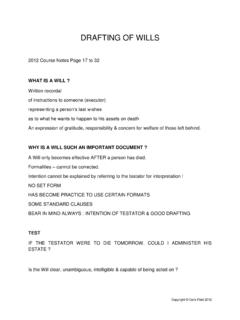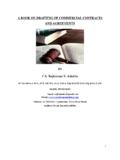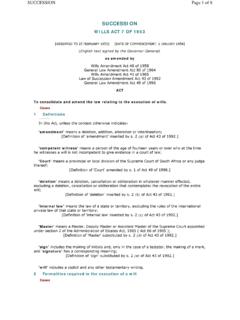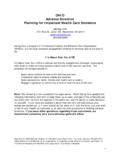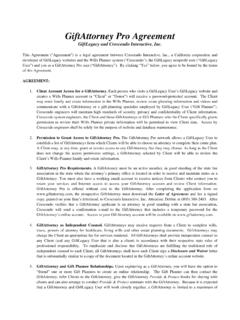Transcription of Drafting Effective Family Law Affidavits and Case Summaries
1 Continuing Professional Development Seminars Drafting Effective Family Law Affidavits and Case Summaries Presenter: Richard Maurice While all reasonable care has been taken by the presenters and authors in presenting this publication, the content, statements and issues raised in this paper are by way of general observation as to the law in a summary form and does not seek to address all legal issues comprehensively and does not constitute advice by the presenters, authors or Continuing Professional Development Seminars Pty Ltd (CPDS) in relation to any particular circumstances which may either directly or indirectly relate to the issues of law addressed in this paper. The views and opinions expressed in this publication are those of the individual presenters and authors, and not those of CPDS.
2 No responsibility or liability is accepted by CPDS for the accuracy of any statement, opinion or issues contained in this publication. CONTINUING PROFESSIONAL. DEVELOPMENT SEMINARS. Continuing Professional Development Seminars Pty Ltd 42 Byron Street North Melbourne, 3051. Phone (03) 9328 2688. Fax (03) 9328 4688. Table of Contents About the Presenter .. 4. Seminar 5. Introduction .. 6. Overview .. 6. Part 1: Effective Family Law 7. Drafting Affidavits for clarity, simplicity and admissibility .. 7. The things in Affidavits that irritate judges .. 7. The differences between Drafting financial and parenting 10. A practical explanation of the relaxation of the rules of evidence in children's cases arising out of sec 69ZT (1) of the Family Law 11.
3 Different approaches to presentation of a case: chronological vs. topic based 12. The proper use of Annexures and Exhibits to 12. Exhibits to Affidavits .. 14. When to use an index and/or table of contents .. 14. Helping Counsel settle what you have drafted .. 15. Part 2: Drafting Case Summaries .. 15. The Chronology .. 15. Balance 20. The Outline of Argument .. 22. Objections to 26. Counsel's 32. Page 3 of 43. About the Presenter Richard Maurice holds degrees in Law and Economics from Sydney University. He was admitted in 1984 and worked in private practice as an employed solicitor in a general practice. About 18 months later he joined the Australian Legal Aid Office (then part of the Federal Attorney General's Department) working as a legal officer where he conducted a diversified practice acting mainly for disadvantaged clients in receipt of Social Security.
4 He also worked as duty solicitor at a number of Local Courts. In 1987 he transferred to the Family Law Section of the ALAO where he worked exclusively in Family Law including, at that time, Defacto property cases and children's cases heard in the Supreme Court relating to ex-nuptial children. He also worked as a duty solicitor in the Family Court at Sydney and Parramatta and in Children's Courts which at time were located at Silverwater and Haberfield. In 1988, not long after the Australian Legal Aid Office merged with the Legal Aid NSW he was called to the private bar. Since then he has practiced mainly in the areas of Family Law, De facto relationships, together with Wills and Probate. He also works as a Mediator in Family Law financial and parenting matters.
5 He is a member of the Family Law Section of the Law Council of Australia and an Associate Member of LEADR the Association of Dispute Resolvers. He has appeared in a number of significant Family Law cases including seminal cases on Family Law and De Facto property division like Pierce and Pierce (1999) FLC 92-844 and Black v. Black (1991) DFC 95-113 as well as in the High Court case of P and P (1994). FLC 92-462 (the first child sterilization case). After 21 years he continues to practice at the private bar in Sydney but travels widely to appear in matters in Brisbane, Canberra and Wollongong. Page 4 of 43. Seminar Programme 9:15 am 9:30 am Registration 9:30 am 9:40 am Introduction 9:40 am 10:15 am Drafting Affidavits for clarity and simplicity 10:15 am 10:45 am Things that irritate judges about Affidavits 10:45 am 11:10 am Admissibility, Annexures, Exhibits & presentation 11:10 am 11:30 am Morning Tea 11:30 am 12:00 pm Drafting Case Summaries generally 12:00 pm 12:30 pm Chronologies and Balance sheets 12:30 pm 12:45 pm The Outline of Argument and Objections 12:45 pm 1:00 pm Concluding comments Questions and Review The above programme is flexible and will be subject to change on the day depending on the requirements of the group who are in attendance.
6 The times used are intended to be indicative only. Page 5 of 43. Introduction This paper is designed to assist both newly qualified and experienced practitioners in Drafting two of the most important documents used in Family Law proceedings. The emphasis is on development of practical skills to ensure that both Affidavits and Case Summaries are prepared in a way that clearly and efficiently conveys your client's case to the Court. The paper deals with such topics as the Effective use of the rules of evidence both to ensure the admissibility of your affidavit evidence and how and when to object to your opponent's written evidence. Also covered are the most Effective methods of the presentation of Affidavits , annexures, exhibits, chronologies and lists of assets.
7 Overview Part 1: Drafting Affidavits In the first half of this seminar we will deal with many significant aspects of Drafting Affidavits , the most important document a litigant relies upon. I will look at different styles and contrast the techniques used for financial and children's Affidavits . I will consider the rules of evidence and their applicability to Affidavits in children's cases and examine the best way of annexing or exhibiting documents to Affidavits in all cases. Part 2: Drafting Case Summaries In the second half we will deal with perhaps the second most important document your client will rely upon; the Case Summary. We will look at all the important aspects of each component of an Effective Case Summary: Chronology. Balance Sheet.
8 Outline of Argument. Objections. The role of Counsel in Drafting and/or settling them. Page 6 of 43. Part 1: Effective Family Law Affidavits Drafting Affidavits for clarity, simplicity and admissibility Without doubt Affidavits are fundamental to the presentation of a strong case. They form the primary evidence upon which your client's case is based. Regrettably however Affidavits regularly develop in a chaotic way. They are often a hotch potch of notes provided from clients derived from their imperfect memories, mountains of documents and the lawyer's own contributions. There are always time pressures and compromises involved. There are arguments with clients about content, form and relevance. Such a recipe can produce an end product distasteful to the pallet of many judicial officers.
9 The starting point for an Effective affidavit is to draft it as a working document; something that a judge will refer to with ease as issues arise. The foundations of any good affidavit therefore are: Clarity, simplicity and admissibility By clarity, I mean that the affidavit should function almost as a reference book for your client's case. By simplicity, I mean that the narrative proceeds in a logical and chronological order which is readily understandable. Finally notwithstanding the relaxation of the rules of evidence in some instances, Drafting an affidavit with reference to the rules of evidence always produces a more credible and understandable document. The things in Affidavits that irritate judges Irrelevant material No matter how much a client wants to include details of their past life history, the personality flaws of their ex-spouse and other material completely irrelevant to the issues in the case you should never include them.
10 Further there is no need for needless repetition of facts, opinions or issues. Rule of the Family Law Rules (2004) provides that: Page 7 of 43. (1) The court may order material to be struck out of an affidavit if the material: (a) is inadmissible, unnecessary, irrelevant, unreasonably long, scandalous or argumentative; or (b) sets out the opinion of a person who is not qualified to give it. (2) If the court orders material to be struck out of an affidavit, the party who filed the affidavit may be ordered to pay the costs thrown away of any other party because of the material struck out. This simply continues, albeit in a stronger form, similar provisions in earlier versions of the Family Law Rules and some memorable reported cases. There is also available to the Court a more general power in sec 135 of the Evidence Act (1995): The court may refuse to admit evidence if its probative value is substantially outweighed by the danger that the evidence might: (a) be unfairly prejudicial to a party; or (b) be misleading or confusing; or (c) cause or result in undue waste of time.
